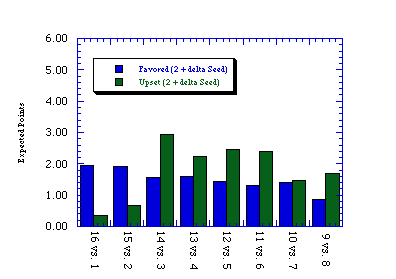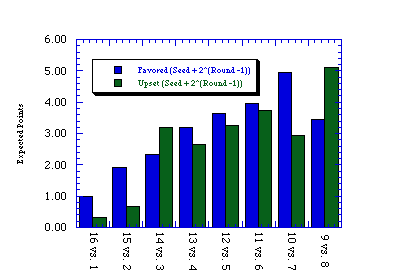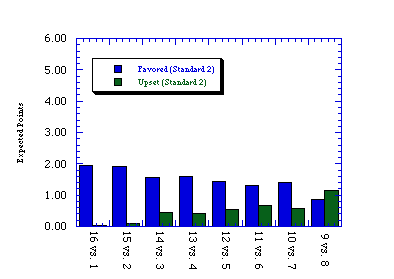
Comparison of Methods
The three methods are:
Example:
Round 1 = 1 * (2 + 1(delta seed)) = 2 + delta seed
Round 2 = 2 * (2 + 1(delta seed)) = 4 + 2*(delta seed)
Round 3 = 3 * (2 + 1(delta seed)) = 6 + 3*(delta seed)
Example:
Round 1 = 2 ^ (1-1) = Seed * 2 ^ 0 = Seed * 1
Round 2 = 2 ^ (2-1) = Seed * 2 ^ 1 = Seed * 2
Round 3 = 2 ^ (3-1) = Seed * 2 ^ 2 = Seed * 4
Example:
Round 1 = 2
Round 2 = 4
Round 3 = 6
First Round Games
In order to entice risk taking, you need to provide the incentive to overcome the potential points that are gambled away in later rounds. This means that the first round should give more points to an upset than a conservative pick because later rounds are where incorrectly picking an upset can be fatal. To see how the three methods compare in this aspect; the points each are expected to give based on the probabilities as determined from previous tournaments are computed and displayed.
In order to determine the probable points, information from previous tournaments is needed. To date, no number 16 seed team has beaten a number 1 seed, so I made up a probability of 2 %. Out of 44 games (up to 1996 tournament), the following probabilities are:
| Game | Favored Wins | Underdog Wins | Percentage Upset |
|---|---|---|---|
| 16 vs. 1 | 44 | 0 | 2% |
| 15 vs. 2 | 42 | 2 | 4.5% |
| 14 vs. 3 | 34 | 10 | 22.7% |
| 13 vs. 4 | 35 | 9 | 20.45% |
| 12 vs. 5 | 32 | 12 | 27.27% |
| 11 vs. 6 | 29 | 15 | 34% |
| 10 vs. 7 | 31 | 13 | 29.5% |
| 9 vs. 8 | 19 | 25 | 56.8% |
From "Neyer's Numbers: Filling out your bracket" by Rob Neyer, ESPNet Sportszone Exclusive, March 1996 and updated to include the 1996 tournament.
Multiplying these probabilities by the points each method gives provides the following:
Method 1

This method gives an advantage for most of the match-ups in the first round to those who pick the underdog. Again, this advantage is necessary because later round points are being gambled away. Also note how the relative amount of points are fairly constant over the range of match-ups.
Method 2

This method gives an advantage for upsets in some games, but still most games the favorite gains more points. Another problem with this method is that it gives varying amount of points to the different games. (i.e. the points awarded increases over the range of games from 1 vs.16 to 8 vs.9.) This is due to the fact that the closer games (i.e. 6 vs. 11, 7 vs. 10 and 8 vs. 9) contain teams with relatively high seeds. This scoring system, therefore, seems to place an artificially higher importance on the closer seeded game (8 vs.9, 7 vs. 10 etc.) than the others. (Of course this may be the intention.)
Method 3

This method provides no incentive to picking an upset. It forces people to follow the seedings and thus the pools are incredibly similar and mind-numbingly boring.
Later Round Games
Of course the pool doesn't just consist of the first round. Later rounds are extremely important as well. How the methods stack up is harder to analyze, however because the data concerning how certain seeds farew against others is often too small and some cases non-existant to use them with any certainty. There are some things to consider however,
| Method | Points |
|---|---|
| Method 1 | 42 |
| Method 2 | 192 |
| Method 3 | 12 |
In this case, Method 2 far and away provides the most reward for the correct pick. Some may question this but consider the odds that the pool sheet went up against. Picking a 6th seed is an astonomically daring move in terms of the odds of it happening and the scoring system should at least try to mirror the odds. Method 1 makes an attempt to award the victor and it is most likely enough to win the pool outright but it does not follow the odds as much as Method 2. Method 3 is a joke.